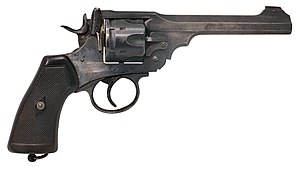Hello ladies and gents this is the viking telling you that today we are continuing our ww1 weapons and today we are talking about

WEBLEY REVOLVER

The Webley Revolver (also known as the Webley Top-Break Revolver or Webley Self-Extracting Revolver) was, in various marks, a standard issue service pistol for the armed forces of the United Kingdom, and the British Empire and Commonwealth, from 1887 until 1963.
The Webley is a top-break revolver and breaking the revolver operates the extractor, which removes cartridges from the cylinder. The Webley Mk I service revolver was adopted in 1887 and the Mk IV rose to prominence during the Boer War of 1899–1902. The Mk VI, introduced in 1915 during the First World War, is perhaps the best-known model.
Firing large .455 Webley cartridges, Webley service revolvers are among the most powerful top-break revolvers ever produced. The .455 calibre Webley is no longer in military service but the .38/200 Webley Mk IV variant is still in use as a police sidearm in a number of countries. With a modified, "shaved" cylinder and the use of a half moon clip, the Webley Mk VI can fire the .45 ACP cartridge, although standard pressure .45 ACP cartridges exceed Webley proof loads and should not be used.
The standard-issue Webley revolver at the outbreak of the First World War was the Webley Mk V (adopted 9 December 1913), but there were considerably more Mk IV revolvers in service in 1914, as the initial order for 20,000 Mk V revolvers had not been completed when hostilities began.On 24 May 1915, the Webley Mk VI was adopted as the standard sidearm for British and Commonwealth troops and remained so for the duration of the First World War
Being issued first to officers, pipers and range takers, and later to airmen, naval crews, boarding parties, trench raiders, machine-gun teams, and tank crews. The Mk VI proved to be a very reliable and hardy weapon, well suited to the mud and adverse conditions of trench warfare, and several accessories were developed for the Mk VI, including a bayonet (made from a converted French Gras bayonet),speedloader devices (the "Prideaux Device" and the Watson design), and a stock allowing for the revolver to be converted into a carbine.
Demand exceeded production, which was already behind as the war began. This forced the British government to buy substitute weapons chambered in .455 Webley from neutral countries. America provided the Smith & Wesson 2nd Model "Hand Ejector" and Colt New Service Revolvers. Spanish gunsmiths in Eibar made decent-quality copies of popular guns and were tapped to cheaply close the gap by making a .455 variant of their 11mm M1884 or "S&W Model 7 ONÁ" revolver, a copy of the Smith & Wesson .44 Double Action First Model.
The Pistol, Revolver, Old Pattern, No. 1 Mk. 1 was by Garate, Anitua y Cia. and the Pistol, Revolver, Old Pattern, No.2 Mk.1 was by Trocaola, Aranzabal y Cia.. Orbea Hermanos y Cia. made 10,000 pistols. Rexach & Urgoite was tapped for an initial order of 500 revolvers, but they were rejected due to defects.
I hope you liked this post and as always have a chilled day from the viking.
Comments
Post a Comment